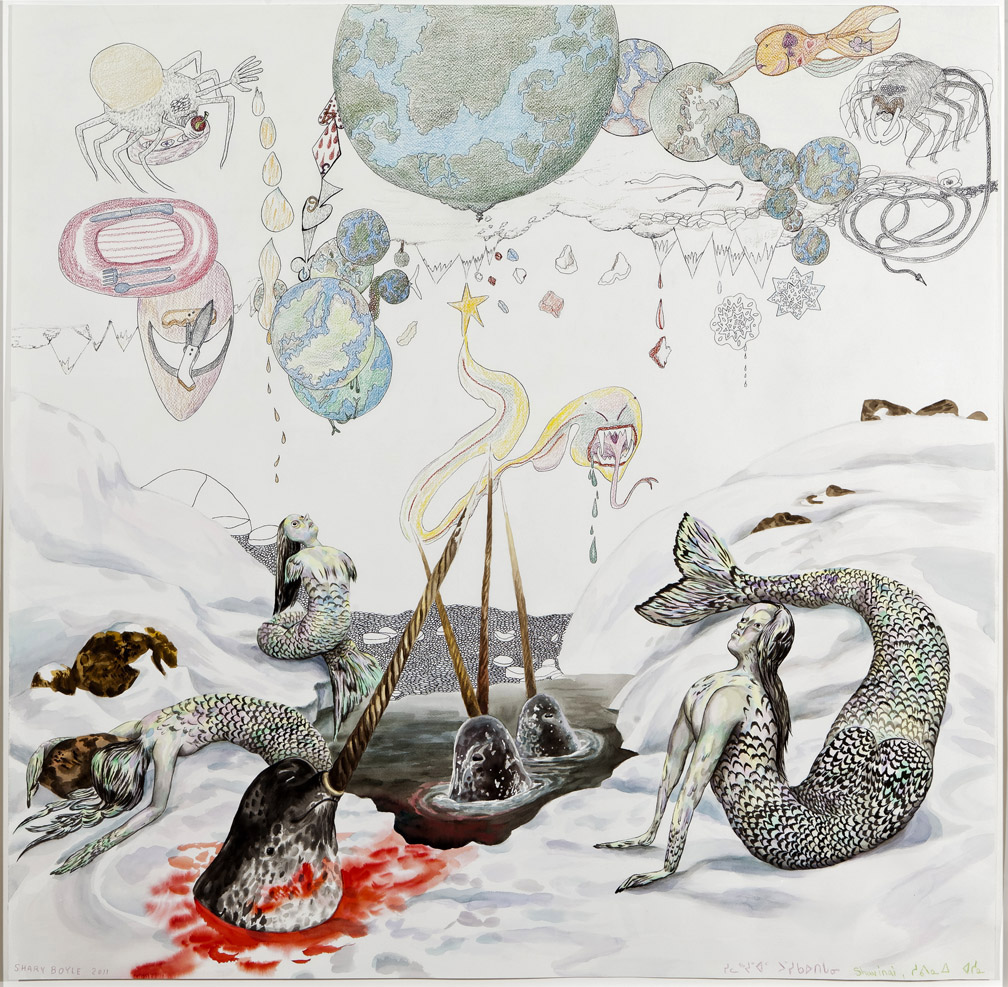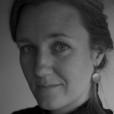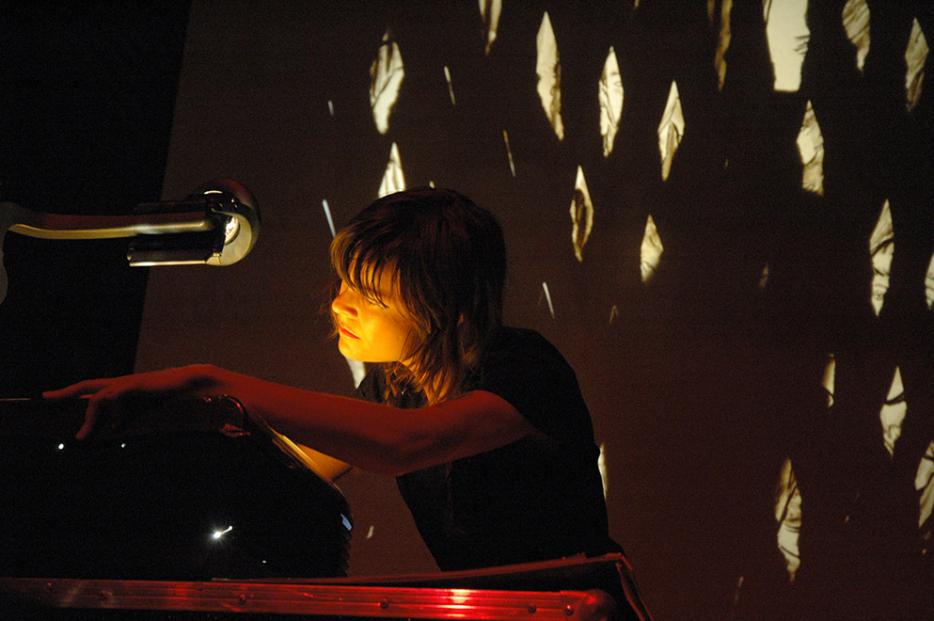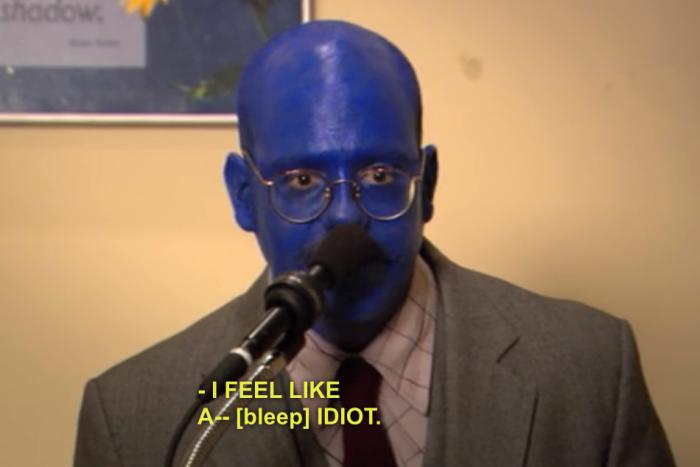I’ve known Shary Boyle for several years. We’re a year apart, and bonded once over the fact that we both owned motorcycles when we were in our twenties. We enjoy talking about our work, mine as a writer, hers as an artist. I love what she makes, how at once strange and familiar it is, how necessary and obvious it feels, even in its dazzling originality. Her drawings, paintings and sculptures often occur to me as evidence—field notes or specimens—of a world whose existence I do not doubt, but only know because she has shown it to me.
I remember sitting in a church hall two summers ago, at an arts festival in Woody Point, Newfoundland, watching Boyle (in her beautiful, nimble way) move around an overhead projector. Down in the front row, with black ink and a brush, she was painting the face of a baby girl onto the bright acetate, the image projected onto a screen, onstage. She was accompanied by Christine Fellows, one of her regular collaborators, singing and playing an original song on piano. By changing the lines, Boyle made the face of the baby girl grow seamlessly into a girl, then an adolescent, a lovely young woman, then someone older, more matronly, a face subjected to the universal effects of time and experience.
The way Boyle manipulated the image with the most simple, deft and confident of brushstrokes was exhilarating to watch. As though you were observing a whole life pass imperfectly before your eyes. I say imperfectly because the image was hand-drawn and spontaneous—it wasn’t digital, or remastered, or airbrushed. It was a living figurative drawing, created in the very moment of witnessing, by an actual artist’s hand. There we were, watching the accelerated ravages of time upon a young woman’s pretty face, the mouth becoming wider, a little turned down at the corners, then wrinkles. The last, somewhat breathtaking move was to remove with a sponge the dark mass of hair on either side of the—by now—old woman’s face. Suddenly, the hair was grey. In the absence of ink, greyness being like that, it was the first fading of a life that had just moments earlier bloomed and flared past adolescence through adulthood. Now it was thinning out toward evaporation, the inevitable snuffing out. The song ended and I could hear, beyond my own ragged breath, other people crying in the room. Boyle had created an epic journey to a better understanding of our mortality, through imagination, metaphor, by proxy and through image. She had illuminated our hopeful, sad, fragile transience. This is the kind of thing she does.
As Canada’s representative at the 2013 Venice Biennale, I wanted to talk to her about what she would be showing. The following is a conversation we had in her house, early one Saturday morning in April, before she left Toronto to begin the six week process of setting up her exhibit, entitled Music for Silence.
--
Yeah, so… Venice.
[Laughter]
I’ve never spoken about a subject so much in one year.
Are you getting totally sick of it?
Well, you know, it’s colonizing. It’s colonized my life, my mind. It’s starting to become a little hard to remember what it was like before it.
Interesting.
Which is really weird.
I could say the same about parenting. I can’t actually remember what my life was like before I had my son.
Yeah…
[The conversation takes a personal turn. Twenty minutes later, we laugh at how off topic we get—talking about women and love and getting older, topics that happen to be closely related to the work Boyle has been making for Venice. Finally the conversation swings back to the upcoming Biennale.]
What’s interesting about what we’ve been talking about, in terms of what I was thinking when I made this work, was the role of aging women—and also the role of mothers. Both subjects are the least sexy and popular and fashionable to take on in the contemporary art world, where it’s all about status and hierarchy, it’s a very cool place. It’s very subtle and distinct about what people can speak about, what material, what medium. It’s not just economic—what people are buying—but what people are writing about, and what art is supposed to be: avant garde, at some level, that has status, and people want the newest thing. But it’s been very academicized for quite some time. What gets left out of that conceptual arena is the… [here she pauses and laughs incredulously] the women and the children.
What counts for avant garde now?
I don’t know, but I guess you could say photoconceptualism. That’s been dominating for some years.
But it still has to be attractive, doesn’t it?
Yeah, it’s not grotesque, by any means, but there’s usually a bit of irony. Architecture has long been a trope that [art] people have been very attracted to; things that involve some kind of theory or philosophy, so that a writer who’s writing a review, for instance, can also know those references and do the back-story through the references. Practically, it’s easier for a reviewer or curator to take on work that has that kind of scholarship associated with it; so they can also be involved and be an active maker in the research of it, the referencing of it, and that comes out of grad school, like everybody’s reading the same books and the same theory.
And all of that sounds so predictable.
But it makes people feel smart. It makes the collector feel smart, it makes the curator feel smart, makes the writer feel smart, makes the artist feel the smartest of all…
It’s safe…
It’s a formula. The Vancouver school [of photoconceptualism] has been going on a long time and it’s a total boy’s club; it’s very much about a certain way of making kind of ironic photography, and photography is a sexy medium. It’s not dirty, it’s clean—it’s really precise, but you can talk about dirty things. You can do it in a very stylized way, so you can be very removed. There’s nothing of the body in it at all. It’s very slick and it’s got a corporate kind of production values, which is sexy and it sells cars, and it sells art.
You look at one of these large-scale photographs they produce, they’re so massive and elegant, so exquisite and clean. It just looks incredible on the wall of, like, a penthouse condo. But there’s no texture, there’s no skin, there’s nothing that’s a bit weird or dirty or personal or intimate in any way. It’s totally anti-intimate. And also the scale—holy God, scale! And massive scale has been a trend in art for the last, I don’t know, 15, 20 years?
What did you think when you first got the invitation to Venice?
At the Biennale, 300,000 people come through the exhibit over six months and they’re international, coming from all different cultures and ages and education levels. There’s tourism, too, and there’s a really educated art crowd, and everything in between, just average folk from the local Venetian community. So I thought about all of that stuff.
You don’t have a lot of time to come up with your idea and my first thought was, what are the kinds of things, what are the feelings, what is the thrust of importance for me that I want to delve into? What is the heart of what I want to present there, and why I want to present it, and then how can I best do that, you know? What characters could I employ to do that?
I’m a figurative artist basically. I use humans—or created characters—to tell stories. And I knew that one of the main characters I wanted to use would be a woman at the end of her life, past her sexual usefulness in society, past her relationship status, nothing about who she’s connected to… her complete independence, an individual at the end of their life. Which is, I thought, such a powerful place, especially for a woman. Women are usually known by their relationships with their children, or partners, or friends. Whatever they are, they’re team builders, it’s like that economic thing I was reading inthe Financial Times recently, about how women approach careers. Studies suggest women approach their corporate careers in terms of what they can do for the team. And they’re very willing to hold themselves back if it’s something they think is going to push their team forward.
I’ve always been interested in looking at a woman in isolation. What is a woman on her own without all of those things, you know? And what is any person, woman or man, it doesn’t matter: what are they at the end of their life when they are about to die? Right in the last moments. What are you? Who are you? Where are you about to go? We’ll never know, but that seems to crystallize your whole thing, you’re right on the cusp of being a spark that’s gone forever. It’s so interesting and powerful to me, this idea of a woman in solitude at the end of her life, but that life keeps on regenerating, you know? It does.
So I didn’t want to make this character that was at the end of her life, necessarily be a mother. But I wanted her body to somehow be linked to the giving of life for the next thing—whether it’s parasitical, and sometimes that is something.
And there’s also an infant [in the work]. I won’t talk about the specifics of it [Boyle is prohibited from describing her show in detail before the Venice opening], but there is a pivotal scene happening between a woman at the end of her life and a newborn infant. They are sheltering together—I knew from the get-go this would be the most uncool thing. I know there will be a large population of people that will look at it and their eyes will glance away, they don’t want to look at it, or they’ll look at it and they’ll cringe, on some level, whether they’d admit it or not. Or they’ll look at it and be like, “God, that is cliché, deeply clichéd,” because the image of a woman and child has been so clichéd throughout art history. And through the world of advertising, and storytelling—it’s the essential image, you know? And this work is being shown in Italy, where it’s all about the Madonna and the child, right?
There was this really stubborn part of me that said these have to be the central characters: the voice of the infant and the voice of the dying, and what they represent, and how they are the least heard somehow. They are also the most solitary characters, from any moment in your life, those are the times when no one else really matters, except your own life force, and nothing else can really touch it. You’re the most independent in a way.
Do you think of your work as a challenge to that clean, cool, aestheticized, monolithic, more masculine kind of art we were talking about earlier—that can be admired, but isn’t intimate, so nothing is personally risked—or is it just coincidental that your stuff stands in opposition to it?
No, I work against it. I feel like it’s necessary. I feel like I almost have a duty, but luckily it aligns already with what I love doing. But I’m also very self-aware of what I’m doing, and how it relates to other ways of making that are really prevalent right now, and whether I’m fitting into that or not. There’s also a difference in terms of production values specifically, because I don’t use ready-made things from the world, or emulate high-end production values.
Everything I make is by hand, and because I’m a figurative artist, there are mistakes, like, I’m human, I’m not a master. But I’m also not… there’s another camp, or school of art, that’s about intentional rawness, intentional, almost amateur kind of… or false amateur, where you’re making something that looks really shitty on purpose and it’s ironic.
But there’s nothing really vulnerable about it.
The fact is, I’m quite earnest about what I make. It’s the earnestness that makes people uncomfortable. I’m trying to do something elegant; I’m trying to do something beautiful. I absolutely believe in my materials, and my hands, and when I make my work I try to just do it the best I can. And it’s not about perfectionism, because I don’t care about perfectionism—it’s about wanting, really loving. I love the forms, they turn into characters and they’re real to me, and I love them, you know what I mean? And I believe in them, and I want them to be real, look real. And I think that they’re beautiful. Some people might be like, “Oh, that’s grotesque.” It’s not Hollywood beautiful, but they’re real, they’re beautiful. So I’m touching bodies all the time and I’m trying to make those bodies as real as I can, and I’m offering them to the world almost collaboratively with themselves. Like I give them the power to make themselves.
You have a very maternal relationship to your work.
It’s maternal, but it’s also weirdly Pinocchio, shamanistic, Doctor Frankenstein, kind of like: I know you. I don’t really know you, but I want to help you come out. I’m like a midwife or something. I want you to come out, and I totally respect you and I will do everything I can to make you come out as best, and healthiest, and the way you need to come out. Not that I’m going to force you to be this thing, because I never quite know; I never quite know, but I believe that it’s in there. And it’s not like I see a rock and I’m going to chip away the rock because there’s this figure inside. It’s not really like that, because I’m actually using soft materials and I’m kind of squishing them into something, it’s more, I guess it’s…
You’re like a medium...
The life spark, that’s what I’m interested in. Working with life spark, and I believe you can do that with art. I believe there are certain types of art that are alive. And it’s not just that they’re alive from their maker’s touch, but that they’re pulling some stuff out of the universe and they’re just kind of carrying it, like a little vessel or something, like a little pouch that’s got rocks in it, that has some energy. That’s the spiritual part of my practice. I feel very much like I’m a conductor of an orchestra of characters and materials that I don’t control or own, in any way. I just work with them to enhance and bring them into being, and I vision this stuff. Obviously, I’m the visioner of it all.
Do you listen to music when you make art?
Yeah, often, not always. Sometimes, it depends what part of the process. When I’m creating, I can’t. When I’m just coming up with the ideas, I can’t. But once I’m in the mode of making the thing that I know I want to make, then I can listen to music.
While making the work I was focusing and thinking a lot about the self-containment of the old woman and the child at those two points in their life. Not only because I wanted to make those uncomfortable characters centre stage, for people to look at and engage with, but I also wanted the work to be about ideas of silence. The exhibit is called “Music for Silence.” That’s what inspired a lot of the work, all of the work, it’s very thematic and holistic, in the whole experience of the pavilion, from the pavilion’s architecture to the treatment of the floor and the walls and the ceiling, and how the works are presented. It’s all of a piece, treated to support my ideas and a feeling that you will experience when going through the space. Ideas of silence are very interesting to me because I think silence is unifying. In a weird way, when we all shut up [she pauses] we just become human together. Language, culture, religion, those things can really feel like—
They’re divisive…
Those are the things that divide us and make us distinct. They’re wonderful and amazing and we love them and we need our distinctions of independence, as individuals and cultures. But they’re also the things that divide us. I was thinking what if we take all language away? Especially in the world of contemporary art, where so much rests upon your education level, artist statements, text accompanying the work, for you to interpret it.
If you look at cave art, 30 000 years ago, we don’t know what they were saying, but we know for sure that it meant something to them and they got it collectively. It was a form of language.
And pictorial.
Totally pictorial, there’s no written language there. There is power to communicate in images that I feel might be more universal, that could sweep everybody in, whereas languages and cultures have become so defined and distinctive.
I’m thinking of your porcelain sculptures—they’re kind of fantastical, like the creatures are fantastical, the people look fantastical, and yet they somehow make me think about real life more than some literal representations of reality.
Oh god yeah, totally. I’m trying to get through the cracks into the heart, because there’s been such a layer of superficial, I think life has been made totally unreal.
And slick, stylized.
Completely unreal. Like you can’t look around at anything… and you know, it’s not real. It’s some weird veneer that’s been put on, and it freaks me out that there’s a massive amount of humans participating and creating that veneer, you know what I mean? And that we’ve all accepted that that’s just what we do.

[Someone rings the doorbell.]
Oh fuck, there’s Goldie. This is my friend, you’re gonna like him.
[Goldie enters. Shary welcomes him and introduces us. We talk about where we live in Toronto, the three-year construction project along Roncesvalles, bureaucracy etc… Goldie is going to Venice. He’s going to show up the day before Shary’s birthday.]
When’s your birthday?
That’s the craziest, I got the invitation to do Venice the day before my fortieth, and then that weekend, my fortieth birthday and the day after, I had to decide. And I decided yes. And then I’ve had my entire fortieth year to make the exhibit, and it opens May 28, which is two days after my forty-first birthday. So really, I will always remember my fortieth year, which is a good distraction from any kind of freak-out I might have had about being forty.
Yeah, it’s great timing, life timing. This is the age for it…
Some things have culminated, that’s for sure…






